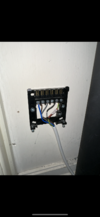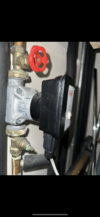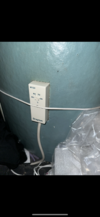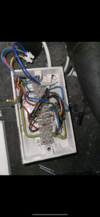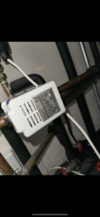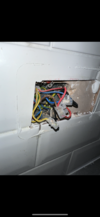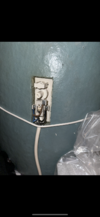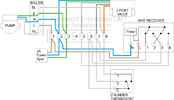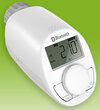Hi all,
I currently have a Y plan heating system that previously had a Hive dual channel system installed.
I had Nest installed recently but it has been giving me problems so I wanted to revert back and as the old wiring was there, I thought it might be straight forward.
The Hive receiver was previously in the kitchen next to the boiler replacing the old thermostat control panel.
The Nest has been wired in the airing cupboard directly into the control center.
I’ve had a look at the old wiring near the boiler which was blanked off, and it seems there is only two spare wires, a yellow and blue wire (I know they can be used for anything in heating systems) bar the live and neutral, I’m thinking these were CH ON and HW ON but I’m confused as there is no HW OFF here?
The Hive was installed by a British Gas engineer and all was working fine.
How could this have been setup?
I can also see the other cables and there is a boiler 5 core wire, a 5 core wire going to the control box upstairs and then a 3 core wire from the FCU and then another 3 core from there to the contol box so I can’t see where the HW OFF would have come from.
The Nest HW satisfied has been wired to the control center to the cylinder stat and 3 way valve satisfied.
I also can’t see any loops in the control center so I’m at a loss.
I’ve wired it back in the airing cupboard with the HW OFF but I’d like to put it back in the original place near the boiler as I’ll need to replace a couple of tiles to make good of the area and blank the existing wiring off.
I also removed the HW OFF after rewiring the hive to see the outcome in case there was something else funky going on but the heating stopped working as expected.
One last thing, there is no loop between CH ON and the 3 way valve as the old room stat was disconnected so I’m not sure if this has any bearing.
Any advice appreciated.
Thanks!
I currently have a Y plan heating system that previously had a Hive dual channel system installed.
I had Nest installed recently but it has been giving me problems so I wanted to revert back and as the old wiring was there, I thought it might be straight forward.
The Hive receiver was previously in the kitchen next to the boiler replacing the old thermostat control panel.
The Nest has been wired in the airing cupboard directly into the control center.
I’ve had a look at the old wiring near the boiler which was blanked off, and it seems there is only two spare wires, a yellow and blue wire (I know they can be used for anything in heating systems) bar the live and neutral, I’m thinking these were CH ON and HW ON but I’m confused as there is no HW OFF here?
The Hive was installed by a British Gas engineer and all was working fine.
How could this have been setup?
I can also see the other cables and there is a boiler 5 core wire, a 5 core wire going to the control box upstairs and then a 3 core wire from the FCU and then another 3 core from there to the contol box so I can’t see where the HW OFF would have come from.
The Nest HW satisfied has been wired to the control center to the cylinder stat and 3 way valve satisfied.
I also can’t see any loops in the control center so I’m at a loss.
I’ve wired it back in the airing cupboard with the HW OFF but I’d like to put it back in the original place near the boiler as I’ll need to replace a couple of tiles to make good of the area and blank the existing wiring off.
I also removed the HW OFF after rewiring the hive to see the outcome in case there was something else funky going on but the heating stopped working as expected.
One last thing, there is no loop between CH ON and the 3 way valve as the old room stat was disconnected so I’m not sure if this has any bearing.
Any advice appreciated.
Thanks!


